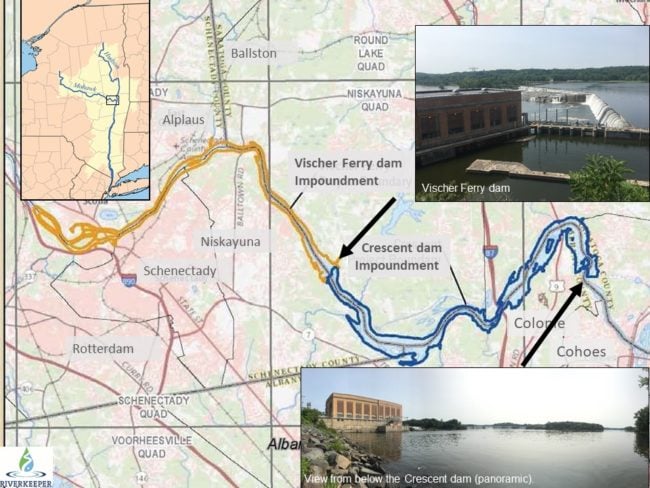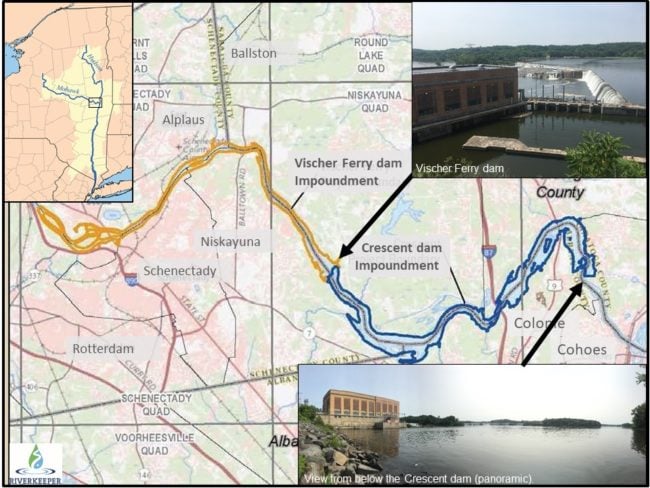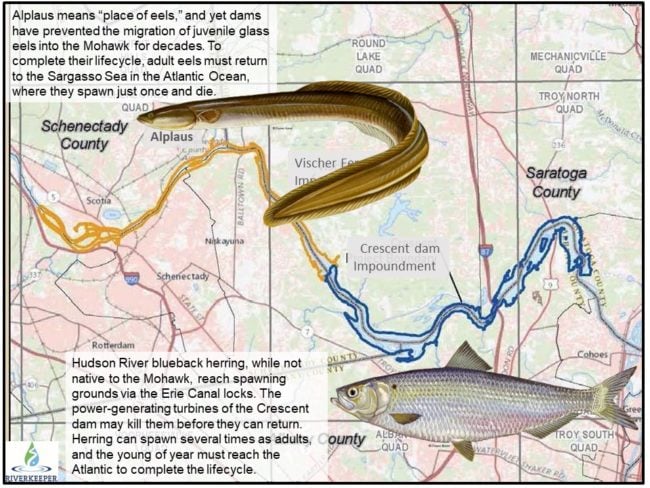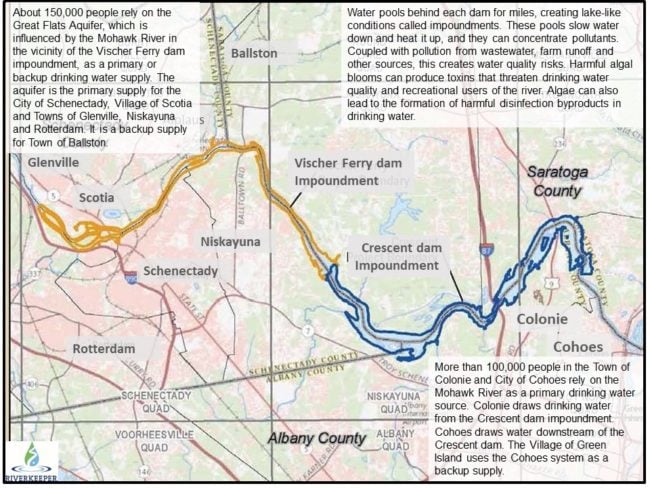Mohawk River dams threaten drinking water quality and damage fish habitat

Images: Wikimedia Commons (inset), NYPA (map), Riverkeeper (photos)
View more images on our Flickr site
As part of our work to restore the abundance of fish and protect water quality in the Hudson and its tributaries, Riverkeeper has begun looking for ways to reduce the significant harms caused by hydroelectric power generation throughout the Hudson River Watershed.
Although hydroelectric power is renewable and often assumed to be “green,” hydroelectric dams have damaging impacts on free-flowing rivers. The migrations of fish and other aquatic are blocked by dams, often eliminating access to essential spawning habitats. Fish and other aquatic creatures may also be killed by the operation of the power-generating turbines. Finally, dams create slow-moving pools of water, called impoundments, which allow water to warm, and can concentrate pollutants, setting the stage for harmful algal blooms and other water quality concerns.
Our goal is to identify measures to lessen the damage caused by these dams and their power generation facilities.
In the Mohawk River watershed, two dams are currently up for relicensing that affect water flow and quality along 20 miles of the Mohawk River, the Hudson’s largest tributary, from Schenectady to Cohoes. These dams, called Crescent and Vischer Ferry, impede migration of herring and American eel, and can maim or kill fish that pass through the turbines. The dams create lake-like pools of slow-moving or still water, which can concentrate pollutants, and threaten drinking water quality for as many as 250,000 people who rely on the river or its associated aquifer as a water source.
One of the dams contributes significantly to the formation of ice jams, which have caused such damaging flooding in Schenectady that authorities are considering a range of strategies likely to cost several millions of dollars to protect the city’s historic district.
The flow of water is a fundamental attribute of a river ecosystem. Flow affects nearly every physical property, including temperature, dissolved oxygen, and sediment movement. These physical properties set the stage for the river’s life.
The Crescent and Vischer Ferry areas include multiple pollution sources, including wastewater treatment plant outfalls, urban areas that shed street water runoff directly into the river, and agriculture that can contribute pollutants like sediment and fertilizers. The conjunction of these pollution sources and water uses makes it extremely important to understand the roles these two dams play, individually and cumulatively, in the ecosystem. As part of the relicensing process, New York Power Authority (NYPA), the hydropower facility owner, will complete environmental studies, and the Federal Energy Regulatory Commission (FERC) will complete an environmental assessment.
In August, Riverkeeper submitted comments on the scope of the assessment and requested certain studies. And we’ve had some success: Based on our comments, FERC broadened the scope of the assessment to include drinking water supplies and increase consideration of wastewater treatment plant discharges, particularly those affecting environmental justice communities nearby.
FERC also expanded the scope of consideration for passage of American eel and blueback herring, and added freshwater mussels to its analysis. (Freshwater mussels need certain migratory fish to spread their larvae, so their populations are linked with fish populations.) And, NYPA added three additional fish studies to its plans.
We still have a lot of work to do, especially to make sure that water quality is given close scrutiny. Water slows at an impoundment, and the backed-up water warms at its surface. With the ample nutrients discharged by wastewater treatment plants, this creates an environment hospitable to algal growth. When algae-rich water is chlorinated to produce safe drinking water, organic matter in the “raw” water and chlorine disinfectant interact to produce compounds that are harmful to human health. There are many such compounds, collectively called “disinfection byproducts.” Some are considered potential human carcinogens, and the entire class of compounds is regulated by EPA and monitored by water suppliers. But responding to disinfection byproducts during water treatment requires drinking water plant operators to monitor and adjust treatment continually and carefully.
A better way to minimize risk is to protect water quality at the source. Unfortunately, NYPA rejected our initial request to study nutrients and algae closely.
We will have more opportunities for comments as the relicensing process, which takes several years, continues. We will continue to call for better analysis of the ways that hydropower dams on the Mohawk are affecting water quality and aquatic species, and to ask FERC and NYPA to identify measures to protect the river and its life.
Would you like to learn more and stay informed? Visit NYPA’s website or email [email protected] and request notice of any public meetings and the availability of information for public review when available.
The Crescent and Vischer Ferry dams are used to generate electricity, and our work there is focused on reducing harm, but there are thousands of obsolete dams that serve no useful purpose and block the passage of migratory fish in the Hudson Valley.
You can learn about Riverkeeper’s effort to remove these dams by visiting this page and by watching a short documentary, “Undamming the Hudson River.”



